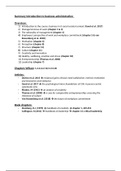Summary Introduction to business administration
Overview:
1) Introduction to the course: business in it social societal context (Gond et al. 2017)
2) Managerial views of work (chapter 1 & 3)
3) The rationality of management (chapter 4)
4) Employees’ perspective of work and workplace commitment (chapter 2 & van
Rossenberg et al. 2018)
5) Motivation (chapter 6)
6) Perception (chapter 8)
7) Structure (chapter 13)
8) Culture (chapter 11)
9) Creativity and innovation
10) Healthy, wellbeing, emotion and stress (chapter 18)
11) Entrepreneurship (Thomas et al. 2000)
12) Leadership (chapter 7)
Chapters Wilson: 1,2,3,4,6,7,8,11,13,18
Articles:
- Devloo et al. 2015 reciprocal gains of basic need satisfaction, intrinsic motivation
and innovative work behavior.
- Gond et al. 2017 the psychological micro foundations of CSR: A person-centric
systematic view
- Rhodes. M (1961) an analysis of creativity
- Thomas et al. (2000) a case for comparative entrepreneurship: assessing the
relevance of culture
- Van Rossenberg et al. (2018) the future of workplace commitment
Book chapters:
- Stemberg, R.J. (1999) handbook of creativity chapter 1, 449-451
- Collingson. K (2011) handbook of leadership chapter 13: critical leadership
, Lecture 1 - Introduction to the course: business in it social societal
(Gond et al. 2017)
Article Gond et al., 2017
CSR
focus on individual employee
individual perception of CSR initiatives
Systematic literature review = analysis/inspection of already published research
Corporate social responsibility (CSR): context-specific organizational actions and policies
that take into account stakeholders’ expectations and the triple bottom line of economic,
social and environmental performance
Conclusions of the article:
1) Interaction between drivers
2) Definition CSR and development of measurement
3) Multiple mechanisms through which CSR can lead to reactions
social exchange, social identity, signaliting and psychological needs
4) Novel individual differences (political preferences)
5) Relationship between CSR and new constructs
6) Dynamic and learning processes
Lecture 2 – managerial views of work (chapter 1 & 3)
Chapter 1 (Setting the scene)
Globalization gradual connection between different societies
global circulation of good, services and capital: information, ideas and
people
Good side to globalization
- access to larger markets
- upscaling of organizations
- access to capital flows, technology, human capital
- cheaper imports & larger export markets
Downside to globalization
- Loss of cultural heritage (offering international brands competing by local brands)
e.g. Douwe Egberts taken over by Starbucks
- Loss of traditional ways of working
- Pollution
- Urbanization
- Power at large
- Same-ness of production (products look the same)
- Long and invisible supply chain (invisible chain from start to end of the product)
Not visible to see who is working in this process. E.g. slavery
, Human trafficking: the supply of human beings for prostitution, sweat shop labor, street
begging, domestic work, agricultural work and other forms of exploitative labor of services.
Youtube: Modern day slavery – supply chains
Social mobility: changes of people from different social backgrounds moving into a given
social class
one main reason for a lack of social mobility: expenses of hinger education
Low social mobility hard for people in lower classes to move to upper classes
High social mobility easier for people in lower classes to move to upper classes by, for
example, go to school etc.
- Better use of human resources
Society based on talents etc. rather than background (parents’ income)
Behavior in organization is dependent on:
- The worker: age, class, status, power, gender, race, religion etc.
- The conditions: type of job, type of contract, part-time, home working
- The wider context: unemployment, aging, social mobility, industry, culture etc.
Theory deduction practice induction
Job segregation = one of the reasons for inequality jobs tend to be seen as either ‘male’
or ‘female’ jobs
Job sharing = a way of sharing heavy management responsibilities. Splitting a full time job
between two people
Chapter 3
Management: mental work (thinking, intuiting, feeling) performed by people in an
organizational context. A position above foreman and above first-level supervision
Managers what do they do?
- Discussion
- Change between tasks, without finishing
- Managers are reacting rather than proactive (planning)
- Managing is a continuous battle with power and respect
Managers Leaders
- Responsible - In charge
- Monitoring organization’s steady - Complex problems
state
- Fixing problems as they arise - Visionary / heroic
- Maintaining stability
Fayol: funcitons of managers:






